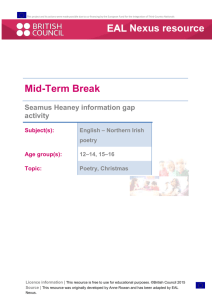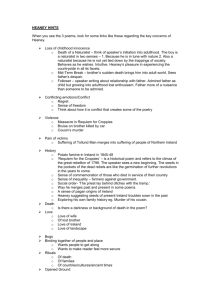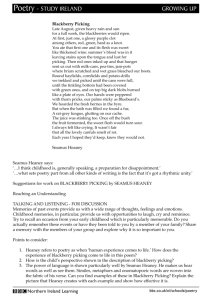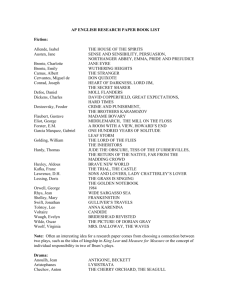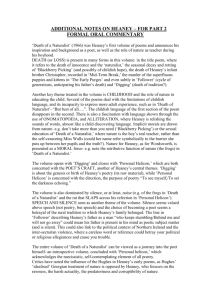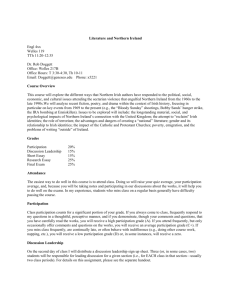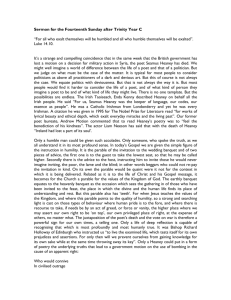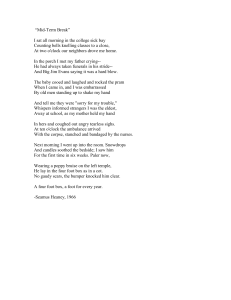Sounds in print, worlds below: Seamus Heaney's deepening words
advertisement
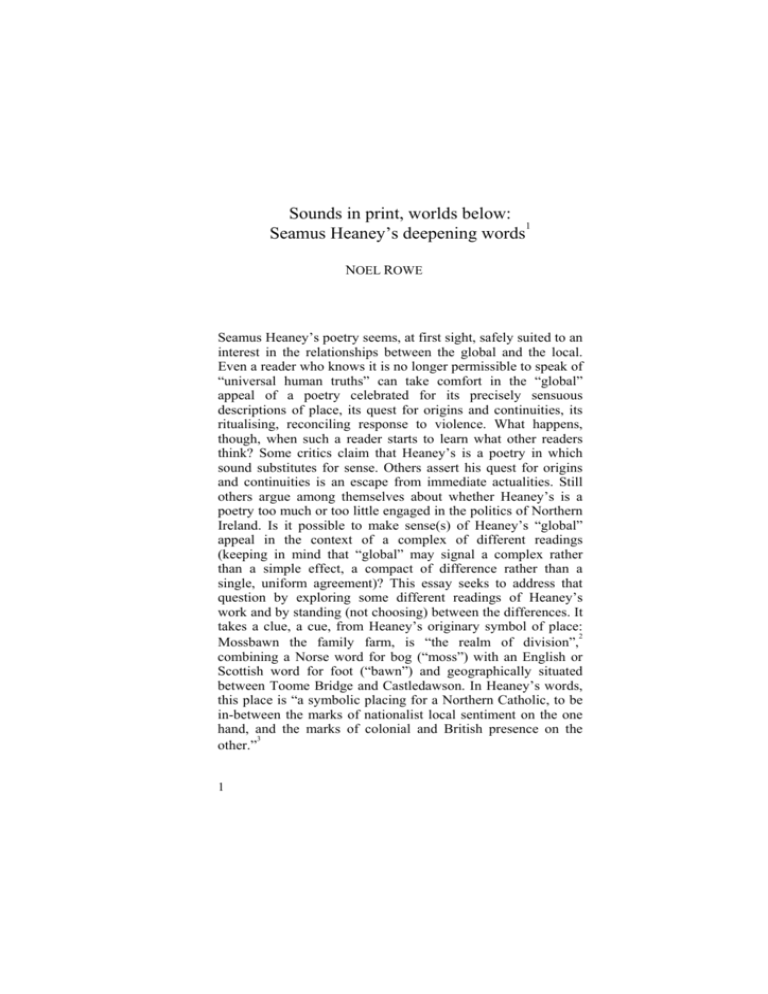
Sounds in print, worlds below: 1 Seamus Heaney’s deepening words NOEL ROWE Seamus Heaney’s poetry seems, at first sight, safely suited to an interest in the relationships between the global and the local. Even a reader who knows it is no longer permissible to speak of “universal human truths” can take comfort in the “global” appeal of a poetry celebrated for its precisely sensuous descriptions of place, its quest for origins and continuities, its ritualising, reconciling response to violence. What happens, though, when such a reader starts to learn what other readers think? Some critics claim that Heaney’s is a poetry in which sound substitutes for sense. Others assert his quest for origins and continuities is an escape from immediate actualities. Still others argue among themselves about whether Heaney’s is a poetry too much or too little engaged in the politics of Northern Ireland. Is it possible to make sense(s) of Heaney’s “global” appeal in the context of a complex of different readings (keeping in mind that “global” may signal a complex rather than a simple effect, a compact of difference rather than a single, uniform agreement)? This essay seeks to address that question by exploring some different readings of Heaney’s work and by standing (not choosing) between the differences. It takes a clue, a cue, from Heaney’s originary symbol of place: 2 Mossbawn the family farm, is “the realm of division”, combining a Norse word for bog (“moss”) with an English or Scottish word for foot (“bawn”) and geographically situated between Toome Bridge and Castledawson. In Heaney’s words, this place is “a symbolic placing for a Northern Catholic, to be in-between the marks of nationalist local sentiment on the one hand, and the marks of colonial and British presence on the 3 other.” 1 Sydney Studies Reading in hope Somewhere at the beginning of reading there is an innocence, and in that innocence I thought it would be easy to write on Seamus Heaney’s poetry. I found the rough notes I had made on the night of 4 October 1994, when I heard him read at the University of Sydney. I looked again at the phrases there: … he took his father’s plough and turned the language over … the passion and clarity of his images … the spirits in his language … the wonderful mix of Yeatsian song and modern, vernacular observation, the lyrical and political … that sense of deep-heartedness and break-through imagery which signals great poetry … and a warm engagement with his audience – he was not performing as “great poet”, he was forgetting himself and mediating the poetry. Under the spell of that night I would certainly have agreed that “Heaney is the physical embodiment of George Moore’s belief that art ‘must be parochial in the beginning to become 4 cosmopolitan in the end’.” I would even have said that to “become cosmopolitan” poetry needed to establish not so much a widening understanding as a deepening sympathy, an effect I would have attributed to Heaney’s clear images, profound rhythms, and homespun symbolism. I would very much have admired the way he combined the lyrical and the political because I am inclined to think a politician’s (dividing) talk less agreeable than a poet’s (deepening) song. Heaney’s is a poetry that works on the sympathies of many readers. Not only do they believe they know what he is talking about; they also trust they share his feeling for his subject. 5 When they read “Digging”, for example, they admire his language: they can feel as well as see his potatoes and peat, they enter the movement of the grandfather’s digging (“Nicking and slicing neatly, heaving sods/ Over his shoulder, going down and down …”). They identify with the story of a son struggling 2 Seamus Heaney’s deepening words to establish his own identity while maintaining continuity with his father by comparing pen to spade. They find their place in a poem they take to be about the desire for place. They might also, if they like poetry to restore them to harmony, agree with P.R. King, who thinks “Digging” is about the poet discovering and locating his vocation within the rural traditions his father 6 embodied, traditions that hold “the historical roots of a nation.” “Personal Helicon” (NSP 9) is about the poet’s power to transform the darkness into rhyme and meaning, while “Requiem for the Croppies” (NSP 12) affirms an heroic and redemptive view of suffering and sacrifice. If they also prefer harmony to conflict, hopeful readers are likely to read poems like “The Tollund Man” (NSP 31), “Punishment” (NSP 71), and “Funeral Rites” (NSP 52), as affirmations of the ritual and mythological imagination, offering a transcendent understanding, rather than a political resolution, of the troubles in Ireland. They might, for example, take comfort from Elmer Andrews, who thinks “The Tollund Man” is itself a transforming ritual: The Tollund Man is more than merely a spiritual ancestor of the Irish dead. His union with the Earth Goddess has initiated a transfiguring process…that is paralleled by his imaginative 7 apotheosis effected through the ritual of art. Politics, for such a reader, is a rhetoric that keeps itself fat on oppositions, whereas poetry, and particularly Heaney’s poetry, unearths a deeper humanity. (The hope, of course, is that humanity gets clearer as we go deeper.) Many critics have remarked on Heaney’s accessibility: however deep the feelings his poetry evokes, it is not difficult to understand and is not, apparently, post-modern. This accessibility is seen as one of the main reasons for his international reputation. Elmer Andrews, introducing Seamus 8 Heaney: A Collection of Critical Essays, shows how Heaney was quickly admired for his capacity to convey the physical particularity of place and to do so in a manner that made his “parochial” scenes generally available. The “universal” appeal of the poetry, according to Andrews, is due to the fact that it 3 Sydney Studies deals with fundamentals. P.R. King declares: “Heaney has proved to be popular with the poetry-reading public, often having an immediate appeal because of his accurate descriptive powers and the clarity of his figurative language”(King 69). Terence Brown agrees: “Heaney can bring everyday natural events before his readers’ eyes with such telling precision that 9 his images are both recognition and revelation.” Neil Corcoran admires Heaney’s onamatopoeia, alliteration and synaesthesia, which allow him to convey the “observed and recollected facts of his early rural experience … in a language of great sensuous richness and directness” (Corcoran 1). Helen Vendler attributes the poetry’s accessibility to its concern with such easily recognisable themes as family and place, as well as its 10 combination of autobiographical and social material. Blake Morrison describes Heaney as “a poet rated highly by the critics and academics yet popular with ‘the common reader’” (Morrison 11). At this point, however, I am not so much reading in hope as cheating criticism. Many of the critics I have just cited have other things to say about Heaney’s work. Andrews concedes that critics strongly disagree about the value of, and values of, Heaney’s poetry. In particular, they disagree about how it relates to what some critics insist is its proper political context, the continuing unrest in Northern Ireland. (Heaney himself remarks on “A public expectation … not of poetry as such but of political positions variously approvable by mutually 11 disapproving groups.” ) Andrews notes, for instance, that (the Protestant) James Simmons accuses Heaney of endorsing tribal positions in his response to atrocity, while (the Catholic) Desmond Fennell believes the poet’s reluctance about public speech has made him evasive and non-committal. As Andrews observes, what both critics have in common is their insistence that Heaney’s poetry renounce its uncertainty in order to side with an ideological position. Vendler, on the other hand, claims it is “a fundamental philosophical mistake” to “read lyric poems as if they were expository essays”, censuring “Heaney’s adversary critics who read the poems as statements of a political position, with which they quarrel” (Vendler 9). Brown goes on 4 Seamus Heaney’s deepening words to argue that Heaney’s “religio-erotic” landscapes are metaphors for a limiting personal vision emerging from “this natural-historical-religio-sexual complex which is his central imaginative obsession” (Brown 28). Morrison advises that the image of Heaney as parish poet, an image he says Heaney has encouraged, is an illusion and that a closer reading will show that the poetry is “rather less comforting and comfortable than has been supposed”, is “tense, torn, divided against itself” (Morrison 2-3). On the other hand, David Lloyd insists that Heaney’s poetry is too comforting and that this is what explains its appeal. It is, says Lloyd, a poetry that satisfies those readers who like to identify the real experience behind a poem, explain metaphors, resolve ambiguities, recognise a unity of tone and feeling, and reach a single, coherent interpretation of the “well12 made lyric poem”. Lloyd goes on to suggest that Heaney’s reputation is an effect of such reading practices, as well as of the “quasi-institutional acceptance” manufactured through school and university courses, critical articles, literary prizes, sales, lecture tours, readings and interviews. Morrison recognises these factors as well, but whereas he takes them to indicate the writer’s ability, Lloyd takes them to indicate the reader’s cultural conditioning. Yet for all their differences, Lloyd and Morrison are making a similar assumption: a poetry deserving wide appeal is a poetry of such intellectual and emotional complexity or depth (they are not necessarily the same thing) that it is capable of engaging further readings, other readings. Reading in trouble Given the divisions over Heaney’s poetry, to say nothing of the divisions within it, it becomes impossible to preserve innocence in reading. It may be possible to preserve hope, but only if hope accepts that it will not be satisfied, that the poetry is always going to do something other than offer achieved order and reconciliation. In order to illustrate how reading Heaney can get you into trouble, I want now to look at the pen/gun/spade analogy in 5 Sydney Studies “Digging”. Blake Morrison maintains the analogy is forced and visually inaccurate, and suggests this is because the poet is over-compensating for his shame at departing from the paternal lineage (Morrison 26). Neil Corcoran and Elmer Andrews make similar points (Corcoran 9, Andrews, The Poetry of Seamus Heaney 40). James Simmons states that the father-son drama is unconvincing and then announces: “Pens are not really squat. If this one is, why does it matter? ‘Snug as a gun’ is a noncomparison. Had there been troubles at that time it would be 13 offensive.” David Lloyd is not impressed by the way the poem reduces physical labour to a metaphor for cultural labour, nor by what he identifies as “the consolatory myth of a knowledge which is innocent and without disruptive effect”: Lloyd 164). William Bedford sees it more in terms of the tension between art and reality, “the language almost physically struggling to 14 assert a mastery of form and metaphor over experience.” Helen Vendler also identifies a tension, but a tension that connects Heaney’s “language” with his “experience”. Vendler points out that the Irish Catholic child grew up between an agricultural tradition that offered the spade and a Republican militarism that offered the gun. Observing that the pen/gun analogy implies “writing as, like war, politics by other means”, she remarks: It is significant that in this – the first poem in his first book – Heaney rejects the concept of writing as aggression, and chooses the spade as his final analogue for his pen: the pen will serve as an instrument of exploration and excavation, yielding warmth (like his grandfather’s turf for fires) and nourishment (like his father’s potatoes) (Vendler 19). Of these readings, I am more inclined to Vendler’s. It takes account of tone. Many of the readings of “Digging” assume that the poem believes in place, whereas the uneasy tone suggests that it wants to believe in place. In “Feeling into Words”, Heaney relates the sense of place to the feeling of imaginative depth, saying of this poem: “This was the first place where I felt I had done more than make an arrangement of words: I felt that I had let down a shaft into real life” (Heaney, Preoccupations 6 Seamus Heaney’s deepening words 41). It is a mistake to confuse the feeling of imaginative depth with the feeling of belonging to place. Imaginative depth can come about when the sense of place is troubled. Heaney’s “Place and Displacement” describes how “Each person in Ulster lives first in the Ulster of the actual present, and then in 15 one or other Ulster of the mind.” This is usually taken to refer to the political situation of writers in Northern Ireland (Heaney goes on to discuss how writers of his generation preferred not to be explicitly political since they saw their art offering subtle and tolerant alternatives to a coarse situation). It could also, however, be seen as evidence that the uneasy belonging experienced by the son/speaker in “Digging”, experienced, that is, in the originary moment of imaginative depth, prefigures how the later poetry will engage with the political troubles of Northern Ireland. Heaney might as easily be describing “Digging” as commenting on poetry and politics when he notes: The poet is stretched between politics and transcendence, and is often displaced from a confidence in a single position by his disposition to be affected by all positions, negatively rather than positively capable. This, and the complexity of the present conditions, may go some way to explain the large number of poems in which the Northern Irish writer views the world from a great spatial or temporal distance, the number of poems imagined from beyond the grave, from the perspective of mythological or historically remote characters. (Heaney, “Place” 8). If all this seems like a lot of fuss over a little pen, it is nothing compared to what happens when critics discuss the politics of Heaney’s poetry (they rarely discuss the poetics of his politics). Given that Heaney himself believes in poetry’s power to heal separations and to transcend the conflictual terms 16 in which Northern Ireland is usually imagined, it is ironic that his work attracts such conflicting assessments. Some critics appreciate the way Heaney’s poetry, with its archeological and ritual imagination, links present violence to a sub-historical urge for sacrifice. This, they suggest, is a more profound response than that offered by partisan politics. Seamus Deane, for example, observes that Heaney’s “instinctive understanding 7 Sydney Studies of the roots of violence is incompatible with any profound repudiation of it” since he sees that “the roots of poetry and the 17 roots of violence grow in the same soil.” Richard Ellmann remarks that, “In a no-win situation, the poet’s duty is to 18 register compassion, not partisanship.” Heaney himself insists that poetry “is not obliged to have any intention beyond its own proper completion” and that, while not absolved from political responsibility, poetry must avoid the “danger of narrowing the range of the mind’s responses to the terms of the disturbance itself” (Heaney, “Place” 8, 6). Other critics accuse Heaney of being too vague in his response to the contemporary situation. Such critics place him in a “no-win situation” since he is accused of condoning IRA atrocity by suggesting that violence is somehow an age-old instinct, but he is also accused of failing to speak up for his (Catholic) people. Commenting on poems such as “The Tollund Man” and “Funeral Rites”, Edna Longley, who believes Heaney’s poetry was better when it kept its politics subtextual, remarks: “The decorative tinge that Heaney imparts to violence and to history derives from a ritualising 19 habit, which itself derives from his religious sensibility.” On the other hand, Conor Cruise O’Brien finds political intensity, reading “Punishment” very much in terms of the IRA, who 20 become “Furies with an ‘understood’ role in the tribe.” David Lloyd maintains that these poems sacrifice the actual to the metaphorical, reducing history to myth (Lloyd 170). Ciaran Carson also objects: It is as if he is saying, suffering like this is natural; these things have always happened; they happened then, they happen now, and that is sufficient ground for understanding and absolution. It is as if there never were and never will be any political consequences of such acts; they have been 21 removed to the realm of sex, death and inevitability. The difficulty is, of course, that such readings go the other way, reducing myth to history and subjecting art to politics. They also ignore the possibility, implicit in Heaney’s work, that politics is itself a poetics. 8 Seamus Heaney’s deepening words Since his archeo-imaginative instinct is to feminise the earth, Heaney has also attracted criticism for supporting binaries that disempower women. Patricia Coughlan provides an important reading of how the poetry uses women and the feminine as the other at the service of male identity. While she agrees with other critics who complain that a poem like “The Tollund Man” makes violence lovely and natural, Coughlan goes further, pointing out that the poem also enacts “erotic absorption and incorporation by a female energy conceived as both inert and devouring.” This, she argues, is yet another of those couplings of eros and thanatos which “generally do seem to rely on a perception of woman as channel for masculine fear and desire.” In her reading of “Punishment” Coughlan observes that the girl is doubly displaced: she is viewed uneasily, and viewed by a (male) speaker who is himself marginalised and covert. Nor is Coughlan convinced by the speaker’s claim to have a troubled compassion for the girl: not only does he have a half-sympathy with the punishers, but also he is excited (sexually, she suggests) by “the scopic spectacle of the girl’s utter 22 dismemberment.” (It might be well to continue this kind of reading. Notice, for instance, that in “Funeral Rites” the women are sidelined as the poem gathers towards its mythic resolution. They are positioned as “hovering/ behind” the speaker, then as “left behind” in “emptied kitchens” – emptied of men, that is, since the “Somnambulent” women are there, “imagining our slow triumph/ towards the mounds”. Meanwhile the movement of the men is likened to that of a – phallic? – serpent entering the “megalithic doorway”. “Personal Helicon” could be read as an erotic exploration of the exotic and illicit feminine space.) Given that such disagreements characterise Heaney’s critical reception, one might be tempted to conclude that his “international reputation” is indeed, as Lloyd suggests, nothing more than the product of prevailing cultural and reading preferences. There are, however, other considerations. It is possible that what we call “global” is a site of difference. It is possible that Heaney’s poetry has wide appeal because it has itself become a disputed territory, a convenient site for critics to argue about the relative merits of traditional or postmodern 9 Sydney Studies reading habits, or about the relationship between poetry and politics. Although the “universal” was traditionally seen as a sign of the same human nature shared by all, it is not impossible that an effect of human and intellectual community can be created by a poetry’s capacity to generate difference, its willingness to entertain many meanings. This might be one of the advantages of Heaney’s kind of lyric poetry: its images exercise power precisely because they are not reducible to one interpretation or position. In this sense, lyric poetry is often more generous in its readability. It is also, of course, possible that different readings are themselves responses to the differences within the poetry. It is possible to read Heaney’s poetry as writing of and in trouble, aware of its own separations and tensions. This allows another way into the poems, one that is alert to their uneasy truces. In “Digging” the apparently clumsy metaphoric manoeuvre that associates pen with gun with spade points to the tension between place and displacement, which corresponds to the tension between connecting with and moving away from the father, which in turn corresponds to the tension between past and future. It is, in other words, a sign of tensions that sustain the poem. “Funeral Rites” knows that it is setting its images of the placatory funeral and the cycle-breaking Gunnar against the world of neighbourly murders and blinded homes. It would be a very different poem if, instead of “I would restore/ the great chambers of Boyne,” Heaney had written “I see restored/ the great chambers of Boyne.” “I see restored” is visionary in tone and perspective, but “I would restore” is less certain since “would” opens a gap between dream and act. This signals that the poem’s pact between history and myth is self-knowing and uneasy. To ignore this is to invest the vision of Gunnar with more healing power than the poem itself does. Gunnar, as many critics note, represents one who breaks the cycle of vengeance and thereby offers a way out of violence, but he is still a figure of desire, marking the absence of, as well as the possibility of, peace. It is also worth remembering that Boyne is not only a river sacred to the old Celtic religion, but also where the Protestant William of Orange defeated the Catholic James II in 10 Seamus Heaney’s deepening words 1690. It can also, therefore, be interpreted as another sign of the conflict between Catholic and Protestant. In “Punishment” it is the misgivings, in tone and perspective, that are valued: I am the artful voyeur of your brain’s exposed and darkened combs, your muscles’ webbing and all your numbered bones: I who have stood dumb when your betraying sisters, cauled in tar, wept by the railings, who would connive in civilized outrage yet understand the exact and tribal, intimate revenge. Critics who write as if this poem is not deeply, dividedly, aware of its complicit gaze are perhaps tone-deaf. The pun in “artful” almost discloses that the poet’s perspective is as manufactured as it is compassionate. The positioning of “exposed” reinforces this, just as “connive” says as much about the speaker in relation to the reader as it does about him in relation to his “poor scapegoat”. The poem is confessing that it is using the girl as its own scapegoat, art’s own redemptive sacrifice. For a critic then to insist that the poem is an unacceptable act of voyeurism is a little like saying poems are no longer allowed to be guilty. Not that the poem is entirely guilty: the ambiguous tone derives from the way the speaker identifies with the victims as well as with the victimisers. Ambiguity is intensified with the use of “exact”. This is a word that might be applied as easily (though differently) to art, politics, murder, or understanding, so that its effect in this poem is anything but “exact”, and quite different from that of alternatives such as “accurate” or “precise”. It is also a word that sounds at once self-satisfied and detached (providing 11 Sydney Studies another version of “artful voyeur”). “The Tollund Man” is also a kind of artful voyeurism, its speaker being intimate with yet alienated from the sacrificial bridegroom and the rites of resurrection, “Unhappy and at home.” Readers who too quickly question whether history can be saved by myth need to keep in mind that the poem is asking itself the same question. In opening up connections between myth and history, between the Tollund Man and the poet, the speaker confides, “I could risk blasphemy.” This is to confess possibilities, to open a space between real and desired worlds. It would be a different poem if he wrote, “I risk blasphemy” (though some critics seem to think he has written just that, resenting an assurance the poem itself does not possess). Similarly, section III has the speaker say, “Something of his sad freedom … Should come to me.” He does not say “comes to me.” The “should” introduces tensions. Is he expecting “sad freedom” to come and/or ordering it? Is he speaking in hope (“should come” because it has not yet arrived but is expected soon) and/or in uncertainty (“should come” because it should have come but has not arrived as expected)? So that, even as it is placing itself within a mythological frame, the poem is displacing itself, becoming itself “lost,/ Unhappy and at home.” In this regard, it is important to understand that “at home” does not resolve “lost”; rather, “unhappy” brings place and displacement into an unsettled agreement. Many of Heaney’s critics seem to want to force a choice between the terms that constitute his uncertainty. This is to convert interaction into opposition (useful for politics, but not for lyric poetry). Whereas, for instance, Heaney makes troubled connections between myth and history, poetry and politics, many of his critics undo them and begin again to exercise their own preferences for myth or history, poetry or politics. This is to subject the poetry to opposing forces, whereas the poetry’s project is to make the opposing forces its subject. Such a project creates an uncertainty and asks reading to enter that uncertainty. Or perhaps it is that such a project does not so much create as reflect a deeper uncertainty, a negative knowing. Heaney, after all, once remarked: 12 Seamus Heaney’s deepening words My childhood was full of death… I’m certain all those funerals and corpses had some definite effect, and I remember after writing ‘The Tollund Man’ I began to think if I were to go to an analyst, he would certainly link the outlined and pacified and rigor mortis face of the Tollund man with all that submerged life and memory (cited Corcoran 237). Leaving aside what it might say about the poet, this opens up the possibility that Heaney’s poetry, coming from a place so familiar with death, keeps its agreements tentative because it knows how much writing is like reading (in) the dark. Reading in the dark It is interesting to note how the poems under discussion position themselves to look at some kind of death. “Digging” is looking down, digging down with its pen/space into memory/grave, until it excavates the dead grandfather who in turn gives the poetry its rhythm and desire (which is also its knowledge that “I’ve no spade to follow men like them.”) “Blackberry Picking” (NSP 5) encounters death at the heart of sensual ease, remembering Keats to the point where it demonstrates its own “negative capability” in “Each year I hoped they’d keep, knew they would not.” “Personal Helicon” is looking into the “dark drop” of a well (Helicon was a stream and source of inspiration to ancient poets). It is looking for a reflection. One might describe a reflection as a recognisable reality that looks back because there is darkness beneath it, and such a description shows how looking for a reflection might be a metaphor for writing and its engagement with the dark unknown. This is what informs the close: “I rhyme/ To see myself, to set the darkness echoing.” “Requiem for the Croppies” gives a reading of a place shamed and sanctified by death: Vinegar Hill, County Wexford, where in 1798 the British suppressed a rebellion of “croppies” (young fighters who had cropped their hair in imitation of the peasants of the French Revolution). “Funeral Rites” sees the poet as pallbearer and 13 Sydney Studies enters imaginatively the pre-Christian burial chambers at Newgrange. In the first section, the eyelids of the dead are “glistening”, while the nail-heads of the waiting coffin-lid are “dressed/ with little gleaming crosses.” It is almost as if they share some illumination brought by death. On the other hand, the second section introduces the homes “blinded” by sectarian violence (“each neighbourly murder”). This is what prompts the desire for a more profound funeral ceremony, one that would enter “the megalithic doorway” and appease poetry and death at their common origin. When this section opens, it could be speaking of poetry as well as of a burial rite: Now as news comes in of each neighbourly murder we pine for ceremony, customary rhythms: The poem goes on to imagine its great cortège, but “ceremony” and “customary rhythms” are terms that might also apply to poetry. Given this possibility, it is significant that the “customary rhythms” reveal themselves as the measure of funeral. “The Tollund Man” and “Punishment” are both readings of burial mounds. They too are funeral rites, but in a way that makes them also marriage rites. In the first section of “The Tollund Man” there is a shifty moment when, by way of an ambiguity, poet and sacrificial victim are identified: In the flat country near by Where they dug him out, His last gruel of winter seeds Caked in his stomach, Naked except for The cap, noose and girdle, I will stand a long time. Bridegroom to the goddess, She tightened her torc on him And opened her fen… 14 Seamus Heaney’s deepening words The positioning of “I will stand a long time” is such that, unless a reader gives it tight attention, it can easily make it seem that it is the speaker who is “Naked” and “Bridegroom” to the spring goddess. This is reinforced by the ending, where the speaker is offering himself as a sacrifice to that knowledge (ultimately of death) which will make him at once “Unhappy and at home.” This ambiguity is not sufficiently valued by those who see the poem as an unwelcome displacement of the political onto the prehistoric. The poem is here admitting not the prehistoric but the immemorial; it is violating the very timeline that Heaney is accused of exploiting in order to evade, or offend, the demands of surface-time political solutions. “Punishment” performs the same violation and with a similarly ambiguous result. The speaker presents himself as lover and betrayer, and the political implications of his gaze have been much discussed, and discussed as if the gaze in question were Heaney’s personal, historical perspective. Yet earlier in the poem the woman-victim has been presented as betrayer and lover: a woman killed for adultery yet wearing the noose as another ring to which she will be forever faithful. The other lover and betrayer in the poem is, of course, death itself, reflected in the unflinching intimacy with which the poem regards, and holds onto, its dead woman, its Eurydice. Seeing the love death has for the “scapegoat”, the speaker can only turn aside, and so the poem ends with a confession that his (and poetry’s?) capacity for love is also his capacity for betrayal. The poem ends where Blanchot says writing begins, with Orpheus’s gaze: It is inevitable that Orpheus transgress the law which forbids him to ‘turn back’, for he already violated it with his first steps toward the shades. This remark implies that Orpheus has in fact never ceased to be turned toward Eurydice: he saw her invisible, he touched her intact, in her shadowy absence, in that veiled presence which did not hide her absence, which was the presence of her infinite absence. Had he not looked at her, he would not have drawn her toward him; and doubtless she is not there, but in this glance back he himself is absent. He is no less dead than she – dead, not of that tranquil worldly death which is rest, silence, and end, but 15 Sydney Studies of that other death which is death without end, the ordeal of 23 the end’s absence. Not only do these poems look at death; death also looks back, making the poems turn away. Unearthing its dead grandfather, “Digging” momentarily savours what comes back with memory: The cold smell of potato mould, the squelch and slap Of soggy peat, the curt cuts of an edge Through living roots awaken in my head. But I’ve no spade to follow men like them. Just as the (grave-) digging spade breaks open memory, negativity enters with the “no” of the spade – a spade which almost immediately is turned into a pen. Under the power of this negativity, the poem has barely enough time to claim its spade/pen analogy and promise to dig with it before silence takes over again. (It is easy to see why some critics think this is a lame ending, but perhaps that is the point: the thought of death may concentrate the mind, but it also stops the tongue.) “Blackberry-Picking” turns its berries into a striking image of dark seeing: “… on top big dark blobs burned/ Like a plate of eyes.” This then governs the last line: “Each year I hoped they’d keep, knew they would not.” The caesura releases the memento mori that prescribes and circumscribes hope. A similar caesura opens up in the last line of “Personal Helicon”: “To see myself, to set the darkness echoing.” By ending here, “Personal Helicon” surrenders itself to the hope that the next word, returning, will be like the sounds found in childhood’s wells, sounds that “gave back your own call/ With a clean music in it.” For some readers, this ending, this hope, is positive: the word redeems the darkness. But that it is to read “the darkness echoing” as if “darkness” is only passive, receiving rhyme, whereas it might as easily be active. Darkness might not simply be, as it were, somewhere safely behind the returning word; it might be within it. It is also worth noting how “echoing” drops away, or “dies”, in sound; it would be a different poem if 16 Seamus Heaney’s deepening words Heaney had written “to make the darkness sing.” “Requiem for the Croppies” would also be different if it could end on “the barley grew up,” but it cannot. Even as it uses the barley carried in the dead croppies’ pockets to create an image of (ongoing) 24 political resurgence, the poem modifies its confidence in resurrection by giving its last look to the grave: “They buried us without shroud or coffin/ And in August the barley grew up out of the grave.” Much has been made of how “Funeral Rites” concludes with its image of (dead? risen?) Gunnar turning to look at the moon. Yet this final section also has Gunnar chanting “verses” within his burial chamber, his realm of death, just as it moves from an image of a grave-mouth stopped with stone to one that is open. Even this, though, hangs on a word: the poem does not actually affirm that Gunnar was chanting, but that “Men said that he was chanting.” This intensifies the sense of the unknown, making the relationship between death and poetry more exact and intimate. “The Tollund Man” makes its opening by turning distance into desire: “Some day I will go to Aarhus.” It is then on this premise, of not having seen the actual “peat-brown head,” but only a photograph of it, that the poem itself becomes a burial site, its “dark juices working/ Him to a saint’s kept body.” Even when it entertains the risk of blasphemy, the poem is engaging with absence and darkness. At one level, it implies that the Catholic saints have lost their power, leaving a space where “blasphemy” is possible; at another level, it expresses belief in an underground sacred, a desire to “Consecrate the cauldron bog/ Our holy ground.” Unlike “Funeral Rites”, “Punishment” has its mouth stopped with “stones of silence.” Once again there are images of seeing and once again they connect sight to darkness. The speaker declares that he “can see her drowned/ body in the bog,” then finds his gaze reflected in “her blindfold a soiled bandage.” Much has been written about how this poem relates love and death, but it might also be read as relating death and writing. When, after all, the speaker calls himself an “artful voyeur” it is not because he finds her simply beautiful. He is voyeur: 17 Sydney Studies of your brain’s exposed and darkened combs, your muscles’ webbing and all your numbered bones. And buried there with her, in “combs” (honeycomb), “webbing” (weaving threads), and “numbered” (using metrical 25 feet), are signs of poetry. Poetry, that is, is beyond the poem’s reach. Even as it watches itself assume determinate shape and rhythm and wrap a meaning round this woman’s corpse, the realised poem is still turning back to, still losing hold of, the beautiful “tar-black face”, the dark face of unrealised poetry. That poetry is the poetry she shares with death, the poetry that keeps all that is unknown. This rigor mortis, this discipline or rite of death, is what underwrites Heaney’s poetry, giving it its profoundly alternative and altering power. It is not simply that Heaney’s poetry writes about death, or even that it uses death to prick the vanity of politics. Death is not so much the poetry’s literal subject matter as a way of figuring its condition, its complicity with the dark unknown. The dark, the unknown, is where poetry comes from, where poetry looks back to, and the dark, the unknown, is also always in front of poetry, calling it to make yet another attempt at saying the impossible. Perhaps this is also what gives Heaney’s poetry its abiding appeal. (The dead are always with us. We often feel that we would like to talk with them again. Perhaps poetry allows us to feel that we almost have. So this is written for Michael Laverty, my grandfather, whose parents came from Ireland and whose voice I nearly heard again the night that Seamus Heaney read.) 1 18 Describing his first reading of Irish poets Thomas Kinsella, John Montague and Richard Murphy, Seamus Heaney says he recognised voices that were “more in tune with the actual voices of my own first world than the ironies and elegances of MacNeice and Eliot ever could have been. At last I had discovered sounds in print that connected with the world below and beyond print I had Seamus Heaney’s deepening words known early on in Co. Derry”: Preface to Poems and a Memoir, selected and illustrated by Henry Pearson with an introduction by Barry Flanagan and a preface by Seamus Heaney (Limited Editions Club, 1982), xviii, cited Neil Corcoran, The Poetry of Seamus Heaney: A Critical Study (London: Faber and Faber, 1998), 242. 2 3 4 5 6 7 8 9 10 11 Seamus Heaney, “Mossbawn”, Preoccupations (New York: The Noonday Press, 1980), 20. Seamus Heaney, “The Saturday Interview”, Irish Times, 6 December 1975, 5. cited Blake Morrison, Seamus Heaney (London: Macmillan, 1982), 40. Richard Kirkland, “Paradigms of Possibility: Seamus Heaney”, in Seamus Heaney, ed. Michael Allen (London: Macmillan, 1997), 254. Seamus Heaney, New Selected Poems 1966-1987 (London: Faber and Faber, 1990), 1. Future references are to this edition, abbreviated as NSP, and are included in the text. P.R. King, “‘I Step through Origins’”, in Seamus Heaney, ed. Harold Bloom (New Haven: Chelsea House Publishers, 1986), 7980. Elmer Andrews, The Poetry of Seamus Heaney: All the Realms of Whisper (London: Macmillan Press, 1988), 64. Seamus Heaney: A Collection of Critical Essays, ed. Elmer Andrews (New York: St Martin’s Press, 1992). Terence Brown, “A Northern Voice” (Bloom 25). Helen Vendler, Seamus Heaney (London: Fontana Press, 1999). Seamus Heaney, Crediting Poetry (New York: Farrar Straus Giroux, 1995), 14. 19 Sydney Studies 12 13 14 15 16 17 18 19 20 21 22 20 David Lloyd, “‘Pap for the Dispossessed’: Seamus Heaney and the Politics of Identity” (quoted in Allen 178). Lloyd further suggests that “Heaney’s quasi-institutional acceptance on both sides of the Atlantic as a major poet and bearer of the tradition coincides with a tendency to regard his work as articulating important intuitions of Irish identity, and as uttering and reclaiming that identity beyond the divisive label, ‘Anglo-Irishness’”(Allen 155-56). James Simmons, “The Trouble with Seamus” (Seamus Heaney, ed. Andrews, 40). William Bedford, “‘To Set the Darkness Echoing’” (Bloom 11). Seamus Heaney, “Place and Displacement” (Peter Laver Memorial Lectured delivered at Grasmere 2 August 1984. Published by the Trustees of Dove Cottage), 4. Seamus Heaney, interview with Barry White, Belfast Telegraph, 29 June 1989, 9; cited Andrews, The Poetry of Seamus Heaney, 78. Seamus Deane, “Seamus Heaney: The Timorous and the Bold” (Allen 70). Richard Ellmann, “Heaney Agonistes” (Bloom 162). Edna Longley, “North: ‘Inner Emigré’ or ‘Artful Voyeur’?”, in The Art of Seamus Heaney, ed. Tony Curtis (Bridgend: Seren Books, 1994), 85. Conor Cruise O’Brien, “A Slow North-east Wind: Review of North” (Allen 26). Ciaran Carson, “Escaped from the Massacre?”, Honest Ulsterman 50 (Winter 1975); cited Andrew Murphy, Seamus Heaney (Plymouth: Northcote House, 1996), 49. Patricia Coughlan, “‘Bog Queens’: The Representation of Women in the poetry of John Montague and Seamus Heaney” (Allen 185205). Seamus Heaney’s deepening words 23 24 25 Maurice Blanchot, “Orpheus’s Gaze”, in The Space of Literature, trans. Ann Smock (Lincoln: University of Nebraska Press, 1982), 172. The poem was written in 1966 to commemorate the 1916 uprising and uncannily predated the renewed violence of 1969 (Heaney, Preoccupations 56). See James McAuley’s “The Muse” and “Invocation” for convenient examples of how weaving and honeycomb symbolise poetry: James McAuley, Collected Poems (Sydney: Angus and Robertson, 1994), 34, 77. NOEL ROWE teaches Australian Literature in the Department of English at the University of Sydney and is a co-editor of Southerly. 21

